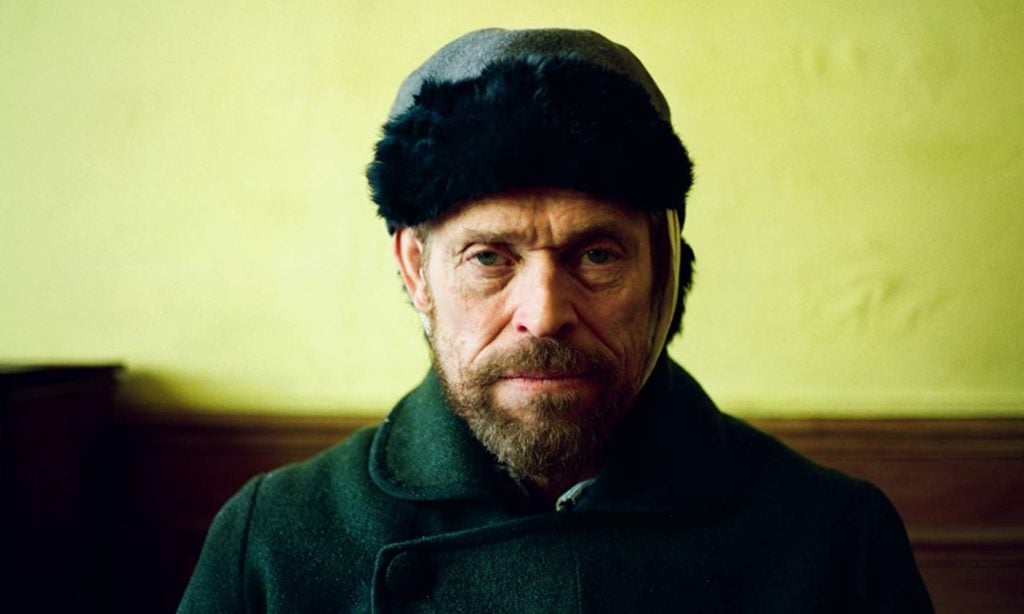Art World
‘It Was Fun to Speak Through Van Gogh’: Julian Schnabel on Writing Dialogue for the Iconic Artist in His New Film
Willem Dafoe's performance as the tormented artist earns rave reviews at the Venice Film Festival premiere of At Eternity's Gate.

Julian Schnabel has channeled his inner Van Gogh, putting himself in the troubled artist’s shoes for a new film he has directed. He also hopes to rehabilitate Paul Gauguin‘s film reputation for being an “asshole” in At Eternity’s Gate, which received its premiere at the Venice Film Festival on Monday.
“It was a lot of fun to speak through Van Gogh,” Schnabel told a press conference in Venice, revealing that he has written some of the dialogue spoken by Van Gogh, who is played by Willam Dafoe. His performance is already being talked about as Oscar-worthy.
As well as the film’s director, Schnabel penned some of the dialogue, including the existential lines of a scene in which a doctor asks Van Gogh “Why do you paint?” to which Van Gogh (Dafoe) replies: “To stop thinking.” The artist-filmmaker says that when he paints, he also stops thinking adding, “I think that could have been true for [Van Gogh] too.”
The inspiration for the film came to Schnabel and his friend, the French screenwriter Jean-Claude Carrière, when they visited the the Musée d’Orsay’s exhibition “Van Gogh / Artaud: The Man Suicided by Society,” in 2014. The Paris exhibition sparked an idea—to make a film about the Dutch painter’s death—was it a suicide or murder? “We started to have conversations around what could have happened,” Schnabel explained.
Four years later, At Eternity’s Gate is earning positive reviews, as Dafoe shines, striding through landscapes, and using his passion for painting as a drug. Named after one of Van Gogh’s final paintings, the film travels next to the New York Film Festival on October 12, and it is due to be released by CBS Films on November 16.
Schnabel insisted that his new Van Gogh film in not a biopic—there are at least 35 films about the artist and his tumultuous life. Schnabel said that he and Carrière were determined to avoid the obvious when they created their impressionistic portrayal. “Everyone thinks they know everything about Vincent Van Gogh,” Schnabel declared at the press conference, wearing his trademark tinted glasses. “It seems absolutely unnecessary and absurd to make a movie about him.”
Schnabel shot the film in the French towns of Arles and Auvers-sur-Oise where the artist spent his final years. It poses arguments of what really happened in his last days. “A lot of the text comes directly from his letters,” Schnabel said. “He was absolutely lucid and knew exactly where he was in relationship to eternity.” He said that they tried to create a feeling “that’s equivalent to observing a work of art.”
Willem Dafoe prepared himself for the role by reading Van Gogh: The Life by Gregory White Smith and Steven Naifeh. He also watched Schnabel working in his studio. “Julian taught me things about paintings,” Defoe told journalists. “I had a shift in a way of seeing that was really crucial to have for some of the things I was doing in the film.”
Oscar Issac, who was a villain in X-Men: Apocalypse, plays Paul Gauguin. Does that make Gauguin a villain, too? Schnabel said he wanted to represent the French artist differently in the film. “Gauguin really cared about him, but Gauguin was always portrayed like an asshole,” said Schnabel, referring to Anthony Quinn’s portrayal of Gauguin in the 1956 Van Gogh biopic starring Kirk Douglas. “Quinn was a fucking asshole in Lust for Life!,” Schnabel declared.
Van Gogh died in 1890 aged 37 from a gunshot wound to the stomach. The fact that the revolver was never found still has experts arguing whether it was a suicide or murder. The filmmakers flirt with the idea that Van Gogh was killed. Carrière said that they had fought against “the dark, romantic legend of Van Gogh,” arguing that he wasn’t “the sad or depressive man people so often describe.” It doesn’t matter to Schnabel. “I don’t care… If he killed himself or not is irrelevant to me,” Schnabel said. “Nobody was there.”
The artist-filmmaker sees further connections between his own life and that of Van Gogh’s, because he had a documentary made about him last year. “Pappi Corsicato made a movie about me and everyone in my family said something different,” said Schnabel. “They’re supposed to know each other.”
Follow artnet News on Facebook:
Want to stay ahead of the art world? Subscribe to our newsletter to get the breaking news, eye-opening interviews, and incisive critical takes that drive the conversation forward.
SHARE

No comments:
Post a Comment